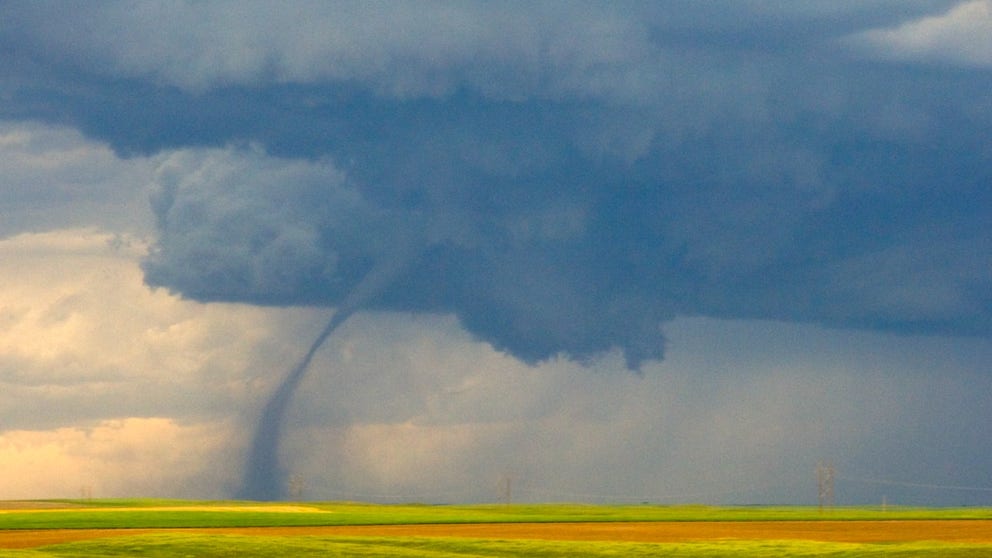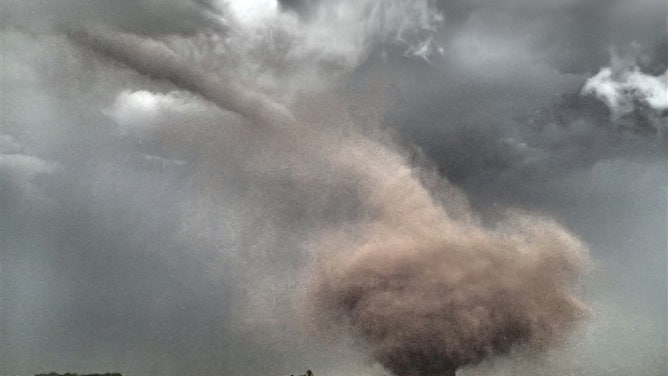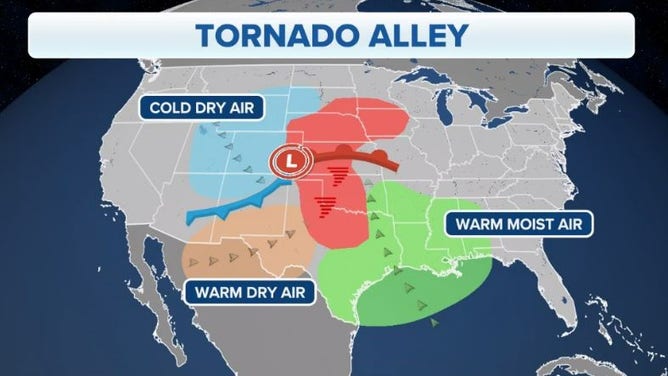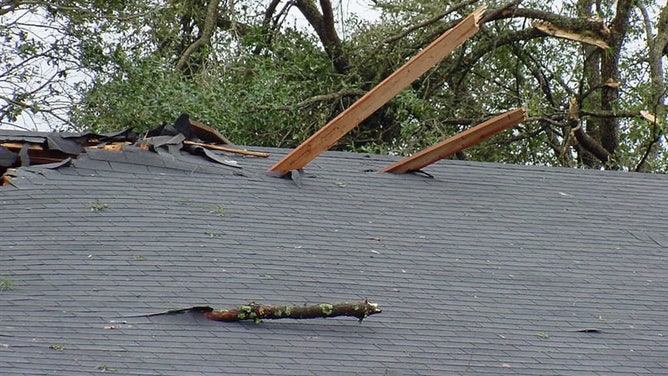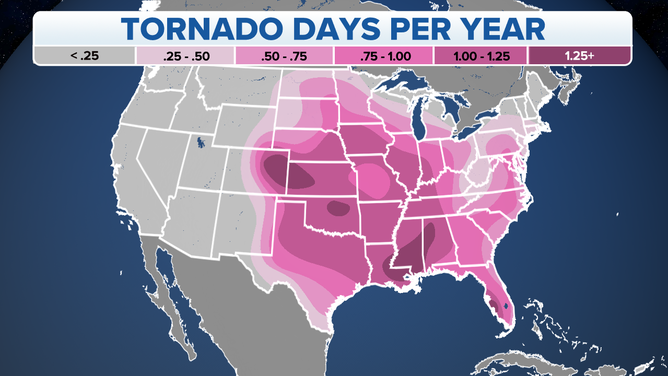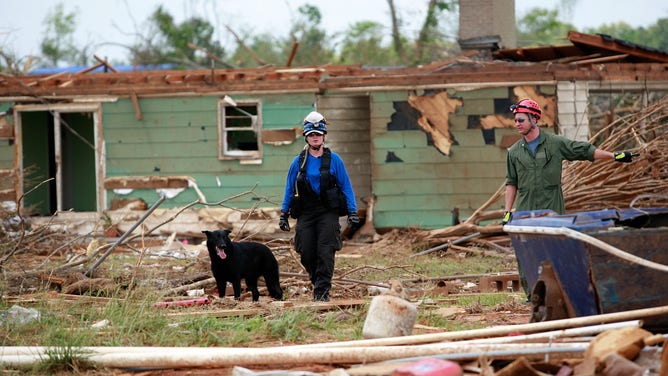Where is Tornado Alley? Everything to know about the American twister hotbed
While Tornado Alley in the Central U.S. is thought of as having the most tornadoes, there are other parts of the country that have similar numbers of twisters.
How long do tornadoes last, and how do they form?
How do tornadoes form? And once they form, how long do tornadoes last?
People throw around the term "Tornado Alley." NOAA claims it is not an official term and that it has been used by the media. Why has it stuck around so long if tornadoes have been reported in every state?
How often have you seen "The Wizard of Oz" and Dorthy getting swept up by the tornado ripping through Kansas farmland? Remember "Twister" where the team of Oklahoma storm chasers and university professors try to insert an experiment into F-4 and F-5 tornadoes? One of tornadoes swallowed a cow.
Movies like these created the reputation of Tornado Alley as the tornado generator or ground zero. Many who hear the term think Tornado Alley is home to the most and strongest tornadoes. Let's find out if that's true.
WE ALL LOVE THE MOVIE ‘TWISTER,’ BUT IS IT SCIENTIFICALLY ACCURATE?
Where is tornado alley?
There is no scientific designation for Tornado Alley, but most people are referring to a stretch from the Great Plains to the Midwest. Where the highest number of average tornadoes per year happen – the Central and Southern Plains – is the heart of the Alley.
The term was coined by two Air Force Weather Officers, according to NOAA. On March 20, 1948, a tornado roared across Tinker Air Force Base near Norman, Oklahoma. Airplanes were flipped over, airmen were injured and power lines were downed. Maj. Ernest Fawbush and Capt. Robert Miller said they had no warning.
WHAT'S THE DIFFERENCE BETWEEN A TORNADO WATCH, TORNADO WARNING AND TORNADO EMERGENCY?
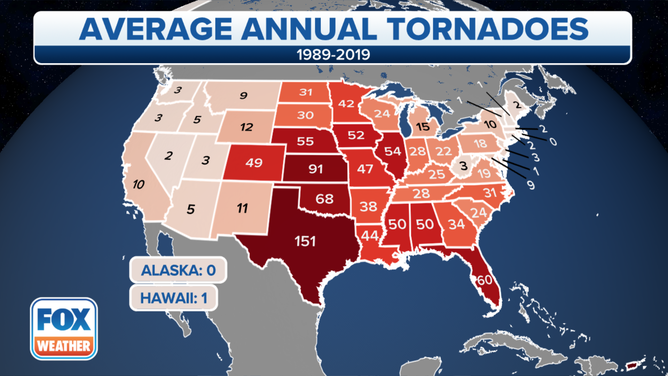
The number in each state denotes its average number of tornadoes each year based on the period from 1989-2019. Data: NOAA/NCEI Storm Events Database.
(FOX Weather)
On March 25, 1948, Fawbush and Miller noticed similar atmospheric conditions to the 20th and put out the first official tornado forecast. It was verified when another tornado hit the base, and tornado forecasting was born in the U.S.
The duo set up a project called "Tornado Alley" to study severe weather from Lubbock, Texas, to Eastern Colorado to Nebraska.
HOW DO TORNADOES FORM AND HOW LONG DO THEY LAST?
Clash of the Air Masses makes Tornado Alley a classic weather set-up for tornado formation.
(FOX Weather)
Why are there so many tornadoes in Tornado Alley?
Check out the Tornado Alley graphic above. The red is a clash zone. Cold, dry (polar) air drops from the Canadian Rockies and West Coast – it is dense and heavy. Warm, moist air (subtropical) is pulled in from the Gulf of Mexico.
Warm, humid air is less dense than cold and dry air, but it's chock-full of potential energy or storm fuel. Think of the cold, dry air as the snowplow and the warm, moist air as snow. The plow digs under the snow and pushes it up, no contest. The clash begins.
Check out the low-pressure center on the lee side of the Rockies on the same graphic. So often, we see disturbances (chunks of energy) or western storms fall apart high over the Rocky Mountains only to have them re-organize east of the Rockies. The low is the match or energy that sets off the explosion between the battle of the air masses.
This battle can happen anywhere, but this is a classic storm scenario in the U.S.
WHICH COUNTRY HAS THE MOST TORNADOES?
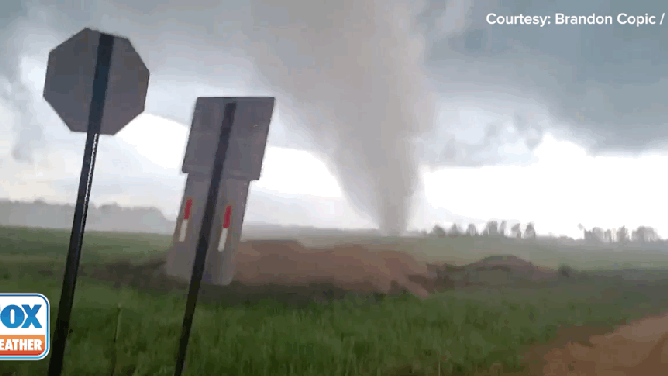
Georgia tornado from April 6, 2022
(Brandon Copic/LSM / FOX Weather)
Are tornadoes in Tornado Alley different from tornadoes in other areas?
Tornadoes are the same meteorological phenomenon whether they happen in Tornado Alley, New York or Italy. The Alley has been very well studied and photographed through the years, adding to its reputation.
For example: Oklahoma sees almost two-thirds of its tornadoes in April and May historically. NOAA's Storm Prediction Center gives advanced notice of the possibility of severe weather, sometimes up to four days out.
So, if a scientist wants to run an experiment or a photographer wants footage, the probability of finding a tornado with advanced warning is higher there. Tornadoes here are most likely in the spring, with a second season in the fall.
A Washington Post article also surmised that studying, seeing and photographing tornadoes is easier in the Plains with flat landscapes and few trees. Weather conditions also make tornadoes hard to capture in other tornado-prone areas like the Gulf Coast.
"Thunderstorms along the Gulf Coast generally form in highly humid environments, resulting in lower cloud bases that can obscure a storm’s structure," said the Post. "Heavy rainfall frequently shrouds any tornadoes that do form. They’re rain-wrapped twisters impossible to photograph. Moreover, thunderstorms in the South are usually quicker-moving."
"With lower cloud levels and (faster storms), essentially they don’t see the tornado coming until it’s right on them," the article continued.
HERE'S WHERE TORNADOES ARE MOST LIKELY TO OCCUR IN EACH MONTH

File: Video by Jason Bednar showing a potentially rain-wrapped tornado in Artichoke, Minn. on Monday, May 30, 2022.
(FOX Weather)
Is this the only Tornado Alley?
The South and Gulf Coast also has an "alley." It stretches across Louisiana, Arkansas, Mississippi, Alabama, Georgia and Tennessee. Like Tornado Alley, this alley is not a scientific description of an area. The National Severe Storms Forecast Center director started referring to the area as an alley after a Feb. 21, 1971, deadly tornado outbreak that spawned nine long-track tornadoes and killed 121 people. The Southern tornado season runs generally from September to May.
An American Meteorological Society Bulletin said, "Research shows there are no tornado risk areas statistically separate from Tornado Alley, but there are large portions of the Southeast that experience more tornadoes than the rest of the country."
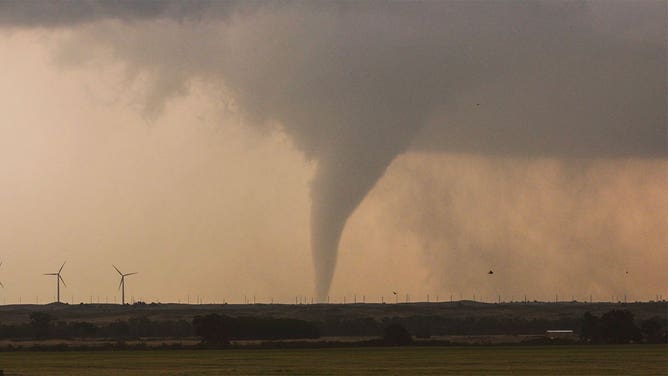
An example of a "stovepipe" tornado.
(Sean Waugh / NOAA / FOX Weather)
The Tornado Days per Year map (below) shows a huge area of the U.S. experiencing one or more tornadoes within 25 miles of a point per year, not just in Tornado Alley.
WHY TORNADO ALLEY IS SHIFTING EAST
Where was the deadliest tornado?
Of the top 10 deadliest tornadoes in the U.S., only one occurred in Tornado Alley, according to NOAA's Storm Prediction Center.
- Missouri, Illinois, Indiana Tri-State region on March 18, 1925, killed 695.
- Natchez, Missouri, on May 6, 1840, killed 317.
- St. Louis, Missouri, on May 27, 1896, killed 255.
- Tupelo, Mississippi, on April 5, 1936, killed 216.
- Gainesville, Georgia, on April 6, 1938, killed 203.
- Woodward, Oklahoma, on April 9, 1947, killed 181.
- Joplin, Missouri, on May 22, 2011, killed 158.
- Amite, Louisiana, to Purvis, Mississippi, on April 24, 1908, killed 143.
- New Richmond, Wisconsin, on June 12, 1899, killed 117.
- Flint, Michigan, on June 8, 1953, killed 116.
HOW ARE TORNADOES RATED? THE ENHANCED FUJITA SCALE EXPLAINED

FILE - An EF-3 tornado moved through Andover, Kansas.
(City of Andover / FOX Weather)
Where was the longest tornado?
Our deadliest tornado holds the longest tornado path record. The Tri-State (Missouri, Indiana, and Illinois) tornado on March 18, 1925, traveled at least 218 miles over 3.5 hours, according to the Guinness Book of World Records. That means the twister was moving at 62 mph on average. The NWS said winds exceeded 300 mph at times, and it was three-quarters to a mile wide.
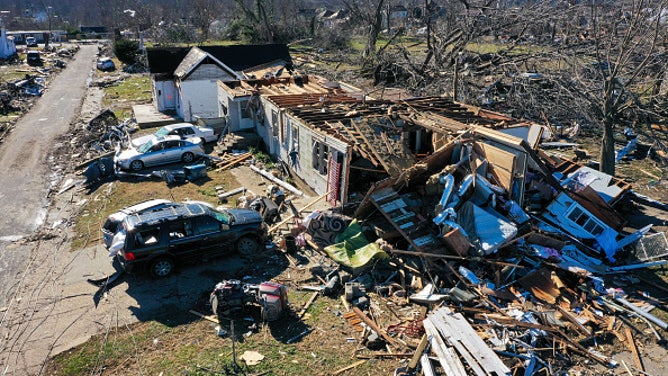
File: An aerial photo shows a damage as cleanup efforts continue after tornado hit Mayfield, Kentucky, United States on December 12, 2021.
(Tayfun Coskun/Anadolu Agency / Getty Images)
What is the record number of tornadoes in an outbreak?
Take another look at the Tornado Alley setup graphic. That represents a single storm system that can touch off multiple tornadoes over several days. That’s called a tornado outbreak. A record 362 confirmed tornadoes struck between April 25-28, 2011.
The NWS said, "April 27, 2011, likely remains the "deadliest day for tornadoes" in the last 85 years. And, the event as a whole killed more people than any outbreak since 1936, when 454 individuals died."
HOW DOES A TORNADO OUTBREAK HAPPEN?
Search and Rescue Specialists search for tornado victims in Tuscaloosa, AL after the 2011 Tornado Outbreak.
(Photo by Tom Pennington/Getty Images / Getty Images)
The outbreak ravaged a dozen states from Texas to Wisconsin to the Carolinas. Three EF-5 tornadoes, 12 EF-4 and 21 EF-3 caused about $12 billion in damage.
May 2004 holds the record for the greatest number of tornadoes in a month – 542.
